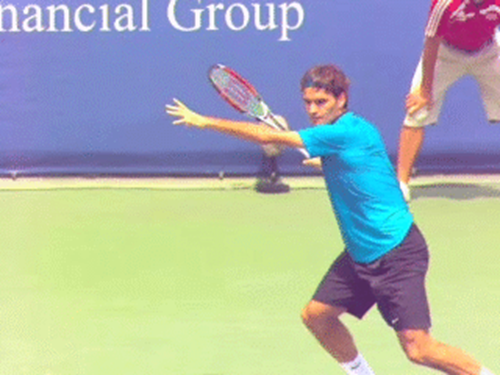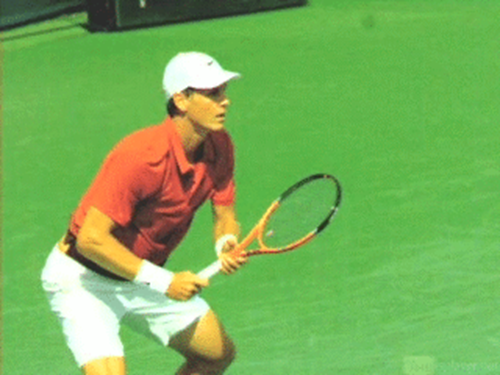1-2 Rhythm: Forehand
Nick Wheatley
![]()
1-2
Rhythm: deliberate then explosive.
This new
series introduces a simple concept I call 1-2 Rhythm. What is 1-2 Rhythm?
1-2 Rhythm breaks the timing of tennis strokes into
two parts, or phases.
Phase 1
is the setup phase, which is smooth and deliberate. Phase 2 is the execution
phase which is explosive and full of energy.
1-2
Rhythm can help players improve their timing and their energy transfer into
their shots. It applies across all strokes, and in this first article we'll see
how that works on the forehand.
A
commonality among elite players is exceptional rhythm. I have found that
focusing on improving rhythm can work wonders for players of all levels, even
those who may have technically less efficient swings.
Transition
To
develop 1-2 Rhythm the first key is understanding the sequence and the
transition from the first phase to the second. When does smooth and deliberate
end and explosive begin?
The
second key is the positioning of the body at this critical transition point. At
this moment what are the key characteristics of the arms, legs, torso and
racket?
Elite English junior players and
the differences in position at the completion of Phase 1
The exact
positions and checkpoints can vary somewhat since even high-level players have
variations in their stroke patterns. But I have found that identifying and
focusing on your own transition checkpoints often leads to better overall
technique.
Phase 1: Smooth and Deliberate
So, let's
identify the two phases in the forehand and the transition point, when Phase 1
ends and Phase 2 begins.
Phase 1: substantial backward racket movement with
the racket head above the racket handle.
Phase 1,
the setup phase, begins with the start of the unit turn and the release of the
opposite hand from the racket. It continues through the completion of the body
turn, with the
opposite arm stretched across the baseline. This smooth
preparation helps to avoid
the common mistake of rushing the racket back too early.
In Phase
1, there is also substantial movement of the racket backwards in the backswing.
Commonly the racket
head will be positioned above the height of the racket handle.
The exact position of the hitting arm and racket can vary, but typically the
racket and hitting arm won’t quite reach the end of the backswing, or the point
where the racket has moved furthest backwards in the swing.
Depending
on the ball, there are also variances in the exact position and movement of the
opposite arm. This can be personal style but it can also be situational.
The more time the player has, the longer the arm
will stay parallel to the baseline. When
players are on the run, it’s likely the opposite arm will have rotated forwards
further up to 30-45 degrees in relation to the baseline.
Phase 2: Explosive
Phase 2: watch the rate of the acceleration
increase.
Phase 2
begins immediately at the completion of Phase 1. Even though we are breaking
the stroke into two parts for the sake of explanation, there is no pause and the
transition should be seamless.
The
racket and hitting arm may not have fully reached the end of the backswing at
this stage. But the crucial point is that at the start of Phase 2, the rate of
acceleration of the arm and racket begins to increase.
This energized and explosive phase is fuelled by
hip rotation, torso rotation and rapid
acceleration of the hitting arm towards contact point. This
explosiveness is what generates and transfers energy into the ball, creating
power and spin.
The
explosiveness will reach its peak at contact point, but the player should imagine that
explosiveness continuing to build through contact and beyond. This will promote excellent extension, and increase the
effectiveness of the shot. The finish will then naturally allow the
arm, and racket to decelerate and recover.
Mastering 1-2 Rhythm is a matter of feeling. The feeling that the stroke is
at first smooth and deliberate, then explosive. The feeling that the key
positions should not be forced. The feeling that the stroke should be flowing.
Phase 2: fueled in part by hip rotation
Execution
To
execute the 1-2 Rhythm on the court, the player needs to simplify the
descriptions of each of the Phases into one key word for each, two words total.
The player can repeat theses key words out loud during practice, and then learn
to say the same key words to himself during match play.
Every
player should find the words that work for him, but here are some examples that
I have found powerful and effective. The first word is "Smooth." The second word is
"Explode."
Another combination is "Slow" then
"Fast." A third is simply
"1-2." In all
cases the first word is said slowly and the second quickly corresponding to the
timing and the feeling of the actual movement.
If you
count frames in the high-speed archive on Tennisplayer you can get a direct
feel for the timing and feeling of the phase. After the split step, the length
of Phase 1 is twice or three times the duration of Phase 2.
Learning
to count 1-2 Rhythm can give any player the same feeling about the parts of the
stroke that great players develop instinctively. I’m a big believer in using
shadow swings to generate this feel, and have my students do shadow swings
before hitting live balls.
Phase 1 can last twice as long or more as Phase 2.
As
development progresses, it is very useful--critical really--to video the
forehand in high speed. The player needs to see actually see himself in the
set-up phase, the execution phase, and of course see what is happening when
part 1 ends and part 2 begins.
Opposite Hand
A critical factor in the effectiveness of forehand
1-2 Rhythm, and the overall timing on the shot is the release of the opposite hand from the
racket. If this is done too early, then it can disrupt the 1-2
Rhythm and affect the timing of the whole shot.
The best way to highlight the importance of the
opposite arm is to watch pro players when they have a short ball. They never
release the opposite hand early. Instead, they move into position with the
opposite hand still on the racket.
Why is
this crucial? Because
when the opposite hand releases, the arm and racket move back independently.
If the opposite hand
releases too early, the arm and racket may slow or even stop at the time that
the explosive phase is beginning and this in turn means that natural momentum
is lost.
Defensive Shots
Using 1-2
Rhythm on defensive shots is more difficult. There is still a clear 1-2 Rhythm
but the timing and emphasis of the key words must be adapted to the reality of
the shot the player is trying to hit.
Watch how Andy keeps his opposite hand on the frame
to maintain 1-2 Rhythm.
The
count, for example, may be faster between the phases. In Phase 2 the feeling of
the explosive phase can be less, but can also be more depending on the pace and
spin the player is creating. The point is the timing and feeling of the key
phrases need to mesh with the feeling of the actual shot.
Indirect
Benefits
Working
on 1-2 Rhythm encourages development of other key skills in a top-class
forehand, often without specifically focusing on them.
Trying to
produce the explosive part 2 naturally helps players be a little quicker
getting positioned for their shot. Instinctively they feel they will have more
explosiveness when they are set up behind the ball.
This also
tends to increase racket acceleration and extension naturally. The emphasis is
on explosiveness through contact. The player however is focused on the simple
keys of the 1-2 Rhythm without artificially attempting to create these
benefits.
So that's
it for 1-2 Rhythm part 1. Stay tuned as we turn next to the backhand.
![]()
|
|
Nick Wheatley is an LTA Performance Coach and
head coach at Hawker Tennis in south west London. His junior teams, the
Hawker Jets, have won 44 competitions since formation, and over the last 2
years alone, his junior players have won 19 singles tournaments between them
at county level. He has been ranked in the top 75 nationally in
35 and over singles and in the top 5 in Surrey county. Nick has done video
analysis for numerous players at all levels, including former British Top 10
player Marcus Willis. His unique teaching video series, covering
every aspect of the game, is available on his website www.nickwtennis.com |








Comments
Post a Comment